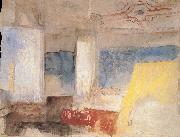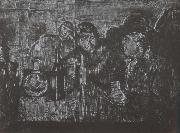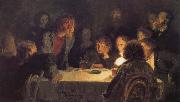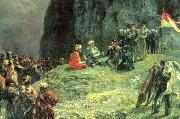Wholesale Oil Painting No Minimum |
|||||||||||
|
|
|||||||||||

|
|||||||||||
|
|
|
||||||||
Joseph Mallord William TurnerEnglish Romantic Painter, 1775-1851 Joseph Mallord William Turner (23 April 1775 ?C 19 December 1851) was an English Romantic landscape painter, watercolourist and printmaker, whose style is said to have laid the foundation for Impressionism. Although Turner was considered a controversial figure in his day, he is now regarded as the artist who elevated landscape painting to an eminence rivalling history painting. Turner's talent was recognised early in his life. Financial independence allowed Turner to innovate freely; his mature work is characterised by a chromatic palette and broadly applied atmospheric washes of paint. According to David Piper's The Illustrated History of Art, his later pictures were called "fantastic puzzles." However, Turner was still recognised as an artistic genius: the influential English art critic John Ruskin described Turner as the artist who could most "stirringly and truthfully measure the moods of Nature." (Piper 321) Suitable vehicles for Turner's imagination were to be found in the subjects of shipwrecks, fires (such as the burning of Parliament in 1834, an event which Turner rushed to witness first-hand, and which he transcribed in a series of watercolour sketches), natural catastrophes, and natural phenomena such as sunlight, storm, rain, and fog. He was fascinated by the violent power of the sea, as seen in Dawn after the Wreck (1840) and The Slave Ship (1840). Turner placed human beings in many of his paintings to indicate his affection for humanity on the one hand (note the frequent scenes of people drinking and merry-making or working in the foreground), but its vulnerability and vulgarity amid the 'sublime' nature of the world on the other hand. 'Sublime' here means awe-inspiring, savage grandeur, a natural world unmastered by man, evidence of the power of God - a theme that artists and poets were exploring in this period. The significance of light was to Turner the emanation of God's spirit and this was why he refined the subject matter of his later paintings by leaving out solid objects and detail, concentrating on the play of light on water, the radiance of skies and fires. Although these late paintings appear to be 'impressionistic' and therefore a forerunner of the French school, Turner was striving for expression of spirituality in the world, rather than responding primarily to optical phenomena. Rain, Steam and Speed - The Great Western Railway painted (1844).His early works, such as Tintern Abbey (1795), stayed true to the traditions of English landscape. However, in Hannibal Crossing the Alps (1812), an emphasis on the destructive power of nature had already come into play. His distinctive style of painting, in which he used watercolour technique with oil paints, created lightness, fluency, and ephemeral atmospheric effects. (Piper 321) One popular story about Turner, though it likely has little basis in reality, states that he even had himself "tied to the mast of a ship in order to experience the drama" of the elements during a storm at sea. In his later years he used oils ever more transparently, and turned to an evocation of almost pure light by use of shimmering colour. A prime example of his mature style can be seen in Rain, Steam and Speed - The Great Western Railway, where the objects are barely recognizable. The intensity of hue and interest in evanescent light not only placed Turner's work in the vanguard of English painting, but later exerted an influence upon art in France, as well; the Impressionists, particularly Claude Monet, carefully studied his techniques. |
||||||||
|
|
||||||||
Meeting
Meeting Painting ID:: 54973 |
mk238
1839
Watercolour
24x30cm
mk238 1839 Watercolour 24x30cm |
|||||||
|
|
||||||||
Edvard MunchNorwegian 1863-1944 Edvard Munch Locations Edvard Munch (pronounced , December 12, 1863 ?C January 23, 1944) was a Norwegian Symbolist painter, printmaker, and an important forerunner of expressionistic art. His best-known composition, The Scream is one of the pieces in a series titled The Frieze of Life, in which Munch explored the themes of life, love, fear, death, and melancholy. Edvard Munch was born in a rustic farmhouse in the village of Adalsbruk in Loten, Norway to Christian Munch, the son of a prominent priest. Christian was a doctor and medical officer, who married Laura Cathrine Bjølstad, a woman half his age, in 1861. Edvard had an older sister, Johanne Sophie (born 1862), and three younger siblings: Peter Andreas (born 1865), Laura Cathrine (born 1867), and Inger Marie (born 1868). Both Sophie and Edvard appear to have gotten their art talent from their mother. Edvard Munch was related to painter Jacob Munch (1776?C1839) and historian Peter Andreas Munch (1810?C1863). The family moved to Kristiania (now Oslo) in 1864 when Christian Munch was appointed medical officer at Akershus Fortress. Edvard??s mother died of tuberculosis in 1868, as did Munch's favorite sister Johanne Sophie in 1877. After their mother's death, the Munch siblings were raised by their father and by their aunt Karen. Often ill for much of the winters and kept out of school, Edvard would draw to keep himself occupied. He also received tutoring from his school mates and his aunt. Christian Munch also instructed his son in history and literature, and entertained the children with vivid ghost stories and tales of Edgar Allan Poe. Christian??s positive behavior toward his children, however, was overshadowed by his morbid pietism. Munch wrote, ??My father was temperamentally nervous and obsessively religious??to the point of psychoneurosis. From him I inherited the seeds of madness. The angles of fear, sorrow, and death stood by my side since the day I was born.?? Christian reprimanded his children by telling them that their mother was looking down from heaven and grieving over their misbehavior. The oppressive religious milieu, plus Edvard??s poor health and the vivid ghost stories, helped inspire macabre visions and nightmares in Edvard, who felt death constantly advancing on him. One of Munch's younger sisters was diagnosed with mental illness at an early age. Of the five siblings only Andreas married, but he died a few months after the wedding. Munch would later write, "I inherited two of mankind's most frightful enemies??the heritage of consumption and insanity." Christian Munch??s military pay was very low, and his attempts at developing a private side practice failed, keeping his family in perrenial poverty. They moved frequently from one sordid flat to another. Munch??s early drawings and watercolors depicted these interiors, and the individual objects such as medicine bottles and drawing implements, plus some landscapes. By his teens, art dominated Munch??s interests. At thirteen, Munch has his first exposure to other artists at the newly formed Art Association, were he admired the work of the Norwegian landscape school, and where he returned to copy the paintings, and soon he began to paint in oils. |
||||||||
|
|
||||||||
|
|
Meeting
Meeting Painting ID:: 55488 |
mk241
1894
mk241 1894 |
||||||
|
|
||||||||
Ilia Efimovich Repinimpression artist Russian, 1844?C1930 |
||||||||
|
|
||||||||
|
|
Meeting
Meeting Painting ID:: 57582 |
mk258 1883 years painting 104 x 173 cm mk258 1883 years painting 104 x 173 cm |
||||||
|
|
||||||||
Grigory GagarinRussian: 11 May [O.S. 29 April] 1811 - 30 January [O.S. 18 January] 1893) was a Russian painter, Major General and administrator. Grigory Gagarin was born in Saint Petersburg to the noble Rurikid princely Gagarin family. His father, Prince Grigory Ivanovich Gagarin (Saint Petersburg, 17 March 1782 - Tegernsee, 12 February 1837), was a Russian diplomat in France and later the ambassador to Italy. His father married in Saint Petersburg in 1809 his mother Yekaterina Petrovna Sojmonova (Saint Petersburg, 23 May 1790 - Moscow, 27 February 1873). Thus until the age 13 the boy was with his family in Paris and Rome and then studied in the collegium Tolomei in Siena. Grigory did not receive a formal artistic education, but took private lessons from the famous Russian painter Karl Briullov who at that time lived in Italy. In 1832 he returned to Saint Petersburg, became acquainted with Alexander Pushkin and illustrated his works The Queen of Spades and The Tale of Tsar Saltan.He also became close to the opposition Circle of Sixteen and Mikhail Lermontov. |
||||||||
|
|
||||||||
|
|
Meeting
Meeting Painting ID:: 76437 |
The Meeting of General Kl??ke von Kl??genau and Imam Shamil in 1837 by Gagarin
cyf The Meeting of General Kl??ke von Kl??genau and Imam Shamil in 1837 by Gagarin cyf |
||||||
|
|
||||||||
|
Grigory Gagarin Russian: 11 May [O.S. 29 April] 1811 - 30 January [O.S. 18 January] 1893) was a Russian painter, Major General and administrator. Grigory Gagarin was born in Saint Petersburg to the noble Rurikid princely Gagarin family. His father, Prince Grigory Ivanovich Gagarin (Saint Petersburg, 17 March 1782 - Tegernsee, 12 February 1837), was a Russian diplomat in France and later the ambassador to Italy. His father married in Saint Petersburg in 1809 his mother Yekaterina Petrovna Sojmonova (Saint Petersburg, 23 May 1790 - Moscow, 27 February 1873). Thus until the age 13 the boy was with his family in Paris and Rome and then studied in the collegium Tolomei in Siena. Grigory did not receive a formal artistic education, but took private lessons from the famous Russian painter Karl Briullov who at that time lived in Italy. In 1832 he returned to Saint Petersburg, became acquainted with Alexander Pushkin and illustrated his works The Queen of Spades and The Tale of Tsar Saltan.He also became close to the opposition Circle of Sixteen and Mikhail Lermontov. Meeting The Meeting of General Kl??ke von Kl??genau and Imam Shamil in 1837 by Gagarin cyf |
||||||||
|
|
||||||||
|
Prev Next
|
||||||||
|
|
||||||||
|
Related Paintings to Grigory Gagarin :. |
||||||||
|
|
||||||||
|
CONTACT US |




